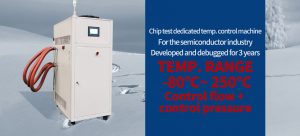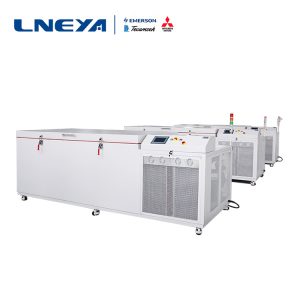O Fenómeno do Gelo Preso no Sistema de Refrigeração a Baixa Temperatura
The phenomenon of ice jam in low temperature chiller system is mainly due to the excessive water in the refrigeration system. With the continuous circulation of refrigerants, the water in the refrigeration system gradually concentrates at the outlet of expansion valve. Because the outlet of expansion valve has the lowest temperature, the water turns into ice and the ice enlarges gradually. To a certain extent, the expansion valve will be completely blocked, resulting that the refrigerant can not be recycled, and the cold storage will not refrigerate.
The phenomenon of ice jam in baixo temperatura sistema de refrigeração is normal in the initial stage. There is frost in the evaporator, heat dissipation of the condenser, stable operation of the unit, clear and stable movement of refrigerant in the evaporator. With the formation of ice jam, the air flow is gradually weakened and intermittent. When the jam becomes serious, the sound of air flow completely disappears. The refrigerant cycle is interrupted. And the condenser is gradually cooled.
Because of the blockage, the exhaust pressure rises. The sound of the machine increases. There is no refrigerant flowing into the evaporator. The frost area decreases gradually. The temperature increases gradually, and the temperature of the expansion valve rises together, so the ice begins to melt. At this time, the refrigerant begins to recycle again. After a period of time, ice blockage occurs again, forming a periodic phenomenon of through-blockage.
Troubleshooting of Ice Block
The ice jam failure of low temperature chiller system is due to excessive moisture in the system, so the whole refrigeration system must be dried. There are two ways to deal with it:
1. Heat and dry the components of the refrigerant system in a drying box. Remove the compressor, condenser, evaporator, expansion valve and return pipe in the refrigerant system from the cold storage and put them into the drying box for heating and drying.
2. Remove the water content of each part of the refrigeration system by heating and secondary vacuum extraction.
Recomendações relacionadas
-
Óleo de transferência de calor de circulador de arrefecimento e aquecimento à prova de explosão
944Explosion proof cooling and heating circulator is a commonly used temperature control equipment in laboratories. It is used in pharmaceutical, chemical, biological and other industries to provide heat and cold sources for reactors, reactors, etc. ...
Ver pormenores -
Purchasing Strategy of Ultra-low Temperature Freezer
926The performance of refrigeration system determines the overall performance. If refrigeration technology is good, excellent refrigeration effect can be achieved quickly. It takes only 4-5 hours on average from room temperature to minus 8 degrees Ce...
Ver pormenores -
Instruções para o ensaio de componentes das empresas de inspeção de pastilhas
979Com o desenvolvimento contínuo da indústria de testes de componentes, surgiram empresas de testes de chips, e a LNEYA também introduziu equipamentos de teste de componentes para testes de chips. O vetor de teste da empresa de inspeção de chips é armazenado no v...
Ver pormenores -
Como lidar com a formação de gelo nos sistemas de refrigeração criogénica?
990Se o sistema de refrigeração a baixa temperatura foi congelado, acreditando que algumas empresas se encontraram, então como devemos lidar com essa situação? Há algum método para resolver este problema. Hoje, vamos saber algo sobre isso com LNEYA refr...
Ver pormenores
 LNEYA Refrigeradores industriais Fabricante Fornecedor
LNEYA Refrigeradores industriais Fabricante Fornecedor













